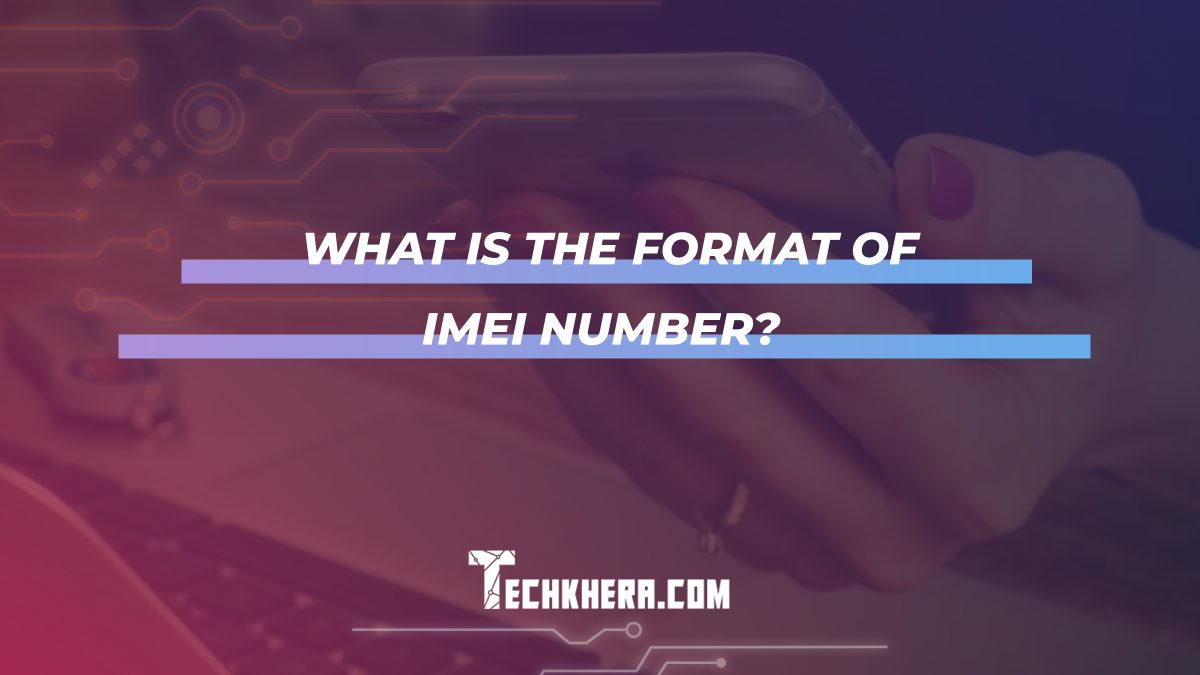
What Is the Format of IMEI Number?
In a world where smartphones have become an indispensable part of our daily lives, there is one mysterious code that holds the key to unlocking a device’s identity – the IMEI number. Have you ever glanced at the back of your phone and wondered what those 15 digits actually mean? Well, prepare to be fascinated as we delve into the intricate world of IMEI numbers and unravel their secrets. From identifying stolen devices to providing crucial information for network providers, the format of an IMEI number serves as a digital fingerprint that carries more significance than meets the eye. So sit back, grab your smartphone, and let’s embark on a journey to demystify this cryptic combination of numbers that plays a crucial role in modern-day technology.
Contents
What is an IMEI number: Definition and purpose
An IMEI number, or International Mobile Equipment Identity, serves as a unique identifier for mobile devices worldwide. This 15-digit code not only distinguishes one device from another but also plays a crucial role in tracking and managing mobile phones. In the realm of cybersecurity, the IMEI number is instrumental in tracing stolen or lost devices and preventing unauthorized access to personal information.
Furthermore, understanding the significance of IMEI numbers can shed light on how manufacturers streamline their production processes and facilitate accurate inventory management. From a consumer perspective, verifying the authenticity of a device through its IMEI number can aid in differentiating genuine products from counterfeit ones. Ultimately, recognizing the importance of IMEI numbers goes beyond mere digits; it underscores the intricate network of technology that safeguards our digital lives.

Structure of an IMEI number: Breakdown of digits
The International Mobile Equipment Identity (IMEI) number holds a wealth of information within its unique structure of 15 digits. Let’s unravel the mystery behind these numbers. The first few digits, typically the first eight, indicate the Type Allocation Code (TAC), which identifies the device manufacturer and model. The following six digits represent the Serial Number of the device, providing a unique identifier for each unit produced.
Moving ahead, the last digit is known as the Check Digit, calculated using a specific algorithm to validate the entire IMEI number’s authenticity. Each part plays a crucial role in identifying and tracking mobile devices globally. This breakdown not only serves practical purposes for telecommunications industry professionals but also sheds light on how intricate and precise technology can be in modern-day mobile communications. Understanding this breakdown can provide insights into how IMEI numbers enhance security measures and streamline operations in our digitally connected world.
How to find your device’s IMEI number: Methods
Finding your device’s IMEI number is crucial for various reasons, such as tracking your phone in case it gets lost or stolen. One common method to locate the IMEI number is by dialing *#06# on your device’s keypad. This simple code will display the unique 15-digit IMEI number on your screen instantly.
Another way to find the IMEI number is by checking the device settings. For iPhone users, go to Settings > General > About, and scroll down until you see the IMEI number listed. Android users can find their IMEI number by accessing Settings > About Phone > Status. Additionally, the IMEI number is usually printed on the original packaging of your device or on a sticker inside the battery compartment for some models.
By familiarizing yourself with these methods of finding your device’s IMEI number, you can rest assured that you have this vital information easily accessible when needed. Remember, keeping track of your IMEI number can provide peace of mind knowing that you have a way to identify and locate your device in any situation.

Validity and uniqueness of IMEI numbers
IMEI numbers play a crucial role in the world of mobile technology. These unique 15-digit codes are not just random sequences but highly structured identifiers that serve multiple purposes. One of the key aspects that make IMEI numbers vital is their validity and uniqueness. Each IMEI number is globally recognized, ensuring that no two devices have the same identifier, making it easier to track stolen or lost phones and prevent fraud.
The validity of an IMEI number extends beyond just authentication; it also serves as a critical tool for network providers to control device access on their networks. This uniqueness allows authorities to identify unauthorized devices quickly, enhancing security measures in place. Moreover, this system enables better anti-counterfeiting efforts by manufacturers as they can track each genuine device throughout its lifecycle.
In essence, the significance of IMEI numbers lies not only in their structural format but also in their unmatched level of identification and security features. The implementation of these unique codes has revolutionized how mobile devices are monitored and protected in today’s digital age, emphasizing the importance of validating every aspect of our technological ecosystem.
Importance of IMEI numbers in device security
IMEI numbers play a crucial role in enhancing device security by acting as a unique identifier for each mobile phone. This 15-digit code not only helps in tracking stolen devices but also enables manufacturers and network providers to keep a database of legitimate devices. By blocking or blacklisting IMEI numbers of stolen phones, it becomes challenging for thieves to resell or use them, effectively deterring theft.
Moreover, IMEI numbers are instrumental in preventing unauthorized access to mobile networks. With the help of these codes, network operators can authenticate devices and ensure that only authorized users can access their services. This added layer of security not only protects the user’s data and privacy but also safeguards against potential cyber threats that may arise from unauthorized use of devices on the network. Ultimately, understanding the importance of IMEI numbers is vital for ensuring the overall security and integrity of our digital lifestyles.
In conclusion, while many users may overlook or underestimate the significance of IMEI numbers, their role in device security cannot be understated. By recognizing and valuing these unique identifiers, individuals can take proactive steps towards protecting their devices, data, and personal information from various risks. Emphasizing the importance of IMEI numbers serves as a reminder that enhancing device security is not just about software updates or antivirus programs but also about leveraging fundamental features like IMEI codes to fortify our digital defenses.

Conclusion: Key takeaways on IMEI format
In conclusion, understanding the format of the IMEI number is crucial for both consumers and industry professionals. The unique 15-digit code serves as a vital identifier for mobile devices, enabling tracking, security measures, and regulatory compliance. Its structured format consisting of TAC, FAC, SNR, and CD forms the backbone for reliable data transmission and accurate identification across networks worldwide.
Moreover, given the rise in mobile device thefts and counterfeit practices, being able to verify the authenticity of an IMEI number becomes paramount. By recognizing valid formats and identifying potential irregularities or inconsistencies in IMEI numbers, users can protect themselves from fraudulent activities and ensure the quality and integrity of their devices. This knowledge empowers individuals to make informed decisions when purchasing second-hand phones or dealing with device-related issues.
To sum up, grasping the nuances of IMEI format not only enhances one’s technical proficiency but also contributes to a safer digital ecosystem. By staying informed about these critical details surrounding IMEI numbers, individuals can navigate the complexities of mobile technology with confidence and security.
